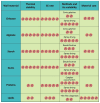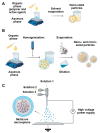Fully Green Particles Loaded with Essential Oils as Phytobiotics: A Review on Preparation and Application in Animal Feed
- PMID: 40867997
- PMCID: PMC12383102
- DOI: 10.3390/antibiotics14080803
Fully Green Particles Loaded with Essential Oils as Phytobiotics: A Review on Preparation and Application in Animal Feed
Abstract
The modern livestock industry incorporates widely used antibiotic growth promoters into animal feed at sub-therapeutic levels to enhance growth performance and feed efficiency. However, this practice contributes to the emergence of antibiotic-resistant pathogens in livestock, which may be transmitted to humans through the food chain, thereby diminishing the efficacy of antibiotics in treating bacterial infections. Current research explores the potential of essential oils from derived medicinal plants as alternative phytobiotics. This review examines modern encapsulation strategies that incorporate essential oils into natural-origin matrices to improve their stability and control their release both in vitro and in vivo. We discuss a range of encapsulation approaches utilizing polysaccharides, gums, proteins, and lipid-based carriers. This review highlights the increasing demand for antibiotic alternatives in animal nutrition driven by regulatory restrictions, and the potential benefits of essential oils in enhancing feed palatability and stabilizing the intestinal microbiome in monogastric animals and ruminants. Additionally, we address the economic viability and encapsulation efficiency of different matrix formulations.
Keywords: animal nutrition; bio-based material; encapsulation; essential oils; phytobiotics.
Conflict of interest statement
The authors declare no conflicts of interest.
Figures







Similar articles
-
Prescription of Controlled Substances: Benefits and Risks.2025 Jul 6. In: StatPearls [Internet]. Treasure Island (FL): StatPearls Publishing; 2025 Jan–. 2025 Jul 6. In: StatPearls [Internet]. Treasure Island (FL): StatPearls Publishing; 2025 Jan–. PMID: 30726003 Free Books & Documents.
-
Ruminant nutrition symposium: novel microbial solutions to optimize production efficiency in beef and dairy systems.J Anim Sci. 2025 Jan 4;103:skaf165. doi: 10.1093/jas/skaf165. J Anim Sci. 2025. PMID: 40372016 Free PMC article. Review.
-
Ophthalmia Neonatorum.2025 Jul 7. In: StatPearls [Internet]. Treasure Island (FL): StatPearls Publishing; 2025 Jan–. 2025 Jul 7. In: StatPearls [Internet]. Treasure Island (FL): StatPearls Publishing; 2025 Jan–. PMID: 31855399 Free Books & Documents.
-
Management of urinary stones by experts in stone disease (ESD 2025).Arch Ital Urol Androl. 2025 Jun 30;97(2):14085. doi: 10.4081/aiua.2025.14085. Epub 2025 Jun 30. Arch Ital Urol Androl. 2025. PMID: 40583613 Review.
-
Recycling Agricultural Waste: Sustainable Solutions for Enhancing Livestock Nutrition.Vet Med Sci. 2025 May;11(3):e70321. doi: 10.1002/vms3.70321. Vet Med Sci. 2025. PMID: 40159453 Free PMC article. Review.
References
-
- Muloi D., Ward M.J., Pedersen A.B., Fèvre E.M., Woolhouse M.E.J., van Bunnik B.A.D. Are Food Animals Responsible for Transfer of Antimicrobial-Resistant Escherichia coli or Their Resistance Determinants to Human Populations? A Systematic Review. Foodborne Pathog. Dis. 2018;15:467–474. doi: 10.1089/fpd.2017.2411. - DOI - PMC - PubMed
-
- Gonzalez Ronquillo M., Angeles Hernandez J.C. Antibiotic and Synthetic Growth Promoters in Animal Diets: Review of Impact and Analytical Methods. Food Control. 2017;72:255–267. doi: 10.1016/j.foodcont.2016.03.001. - DOI
-
- Anadón A. WS14 The EU Ban of Antibiotics as Feed Additives (2006): Alternatives and Consumer Safety. J. Vet. Pharmacol. Ther. 2006;29:41–44. doi: 10.1111/j.1365-2885.2006.00775_2.x. - DOI
Publication types
Grants and funding
LinkOut - more resources
Full Text Sources

